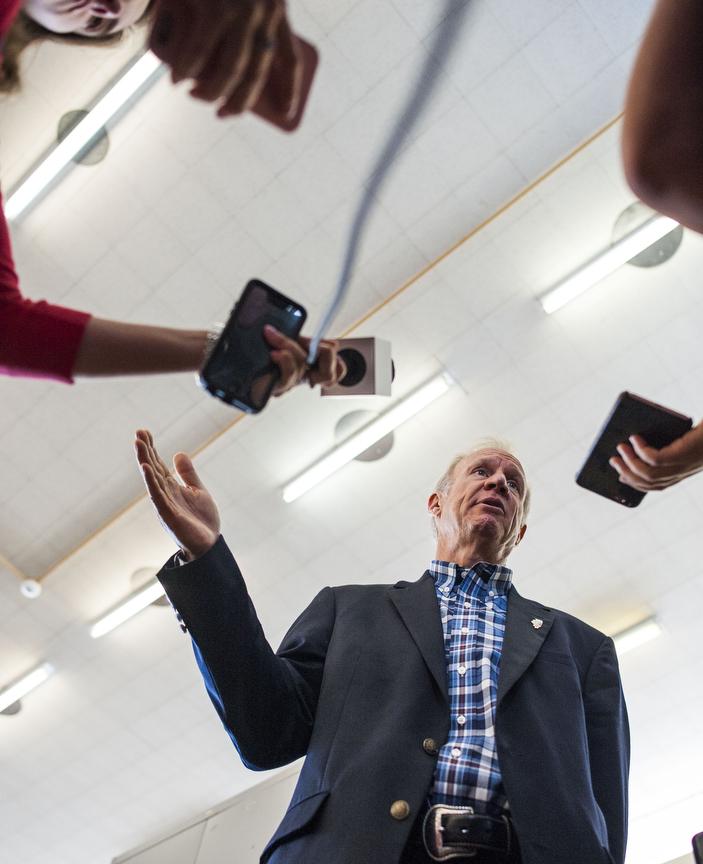Funding bill passes, but schools are still waiting for answers, dollars
Gov. Bruce Rauner speaks with members of the media Friday, Aug. 26, 2016, following his visit to Carbondale High School’s Rebound program. (Ryan Michalesko | @photosbylesko)
September 8, 2017
Local school superintendents said they were happy Illinois Gov. Bruce Rauner and the General Assembly came to a compromise on a school funding bill last week. But how the new law will impact their districts is still not completely clear.
“It is a relief to finally have an evidence-based funding model,” Dawn Elser, superintendent of Central School District 104 in O’Fallon. “With the passing of Senate Bill 1947, schools will finally receive the funds that were not paid by the state this school year, specifically the first two General State Aid payments. This evidence-based funding model will begin to fix the equity gap or at least puts the schools on a path that will lead to equity and adequacy for all students.”
After earlier vetoing Senate Bill 1, Rauner signed a compromise bill for Illinois public schools (Senate Bill 1947) into law on Thursday, Aug. 31. The evidence-based funding proposal in it was similar to that of Senate Bill 1, but SB 1947 also included $75 million in tax credits for people who donate money to private schools for financial need-based scholarships. There is also a provision for voter-initiated referendums for school districts that have certain funding levels.
Advertisement
“This compromise also provides much-needed mandate relief for school districts and presents avenues for property tax relief,” Rauner said. “School districts will be given flexibility in how they schedule physical education curriculum and how they administer driver’s education curriculum. In more affluent school districts, this bill provides taxpayers with a chance to lower their property taxes through the referendum process.”
However, Elser said she mixed feelings about the bill as a whole.
“We are concerned that the two compromises — the voucher/tax credit pilot program and the voter-initiated referendum that exist in this reform — could have an impact on our funding. We will have to wait and see how our district is impacted, but we are concerned that the voucher program may be harmful to our district in the future. We definitely could lose students to the voucher program,” Elser said.
Darcy Benway, O’Fallon Township High School District 203 superintendent, said she still needs some clarification before she could assess the total impact of the legislation.
“At this time, it is not clear what the net total impact of the legislation will be. OTHS is waiting guidance and information from the Illinois State Board of Education (ISBE),” Benway said.
As of right now, ISBE does not have any numbers to give, nor will they for a “a few months,” according to a press release issued Aug. 31.
“The EBF formula requires ISBE to go through a data-verification process with school districts to ensure all of the data incorporated into the formula is accurate,” the release said.
Advertisement*
Once the guidelines related are received from ISBE, Benway said she would be better be able to evaluate the impact legislation.
“At this time, too much is still unknown regarding the rules and implementation requirements related to some of the component parts of the legislation,” she said.
Dale Sauer, Shiloh SD 85 superintendent, said he, too, is in a wait-and-see mode.
“Our budget will likely need to be amended later in the year to account for any changes,” Sauer said. “Like other school districts, we’ll need to let details of the law come to light in order to better understand the full effect on our schools.”
In the meantime, ISBE said it will be working as quickly as possible to issue vouchers to the Illinois State Comptroller so that her office can make payments. Initial payments to school districts will be the preliminary base-funding minimum amounts based on final fiscal year 2017 distributions. This means districts will receive hold-harmless payments until ISBE completes its EBF calculations. The estimated timeline for school districts to receive a first payment was late this week.
“We are told that initial payments, which will first be distributed twice a month, beginning in September, will be based on preliminary base-funding minimum amounts based on final fiscal year ’17 distributions. The base-funding minimum amounts were intended to ensure that no district lost dollars compared to FY17,” said Carrie O’Fallon School District 90 superintendent.
Going forward, districts will receive payments on the 10th and 20th of each month from, September through June in fiscal year 2018. In future years, the schedule will remain the same as General State Aid was previously distributed — 22 payments in total, distributed August through June.
___
(c)2017 the Belleville News-Democrat (Belleville, Ill.)
Visit the Belleville News-Democrat (Belleville, Ill.) at www.bnd.com
Distributed by Tribune Content Agency, LLC.
Advertisement








